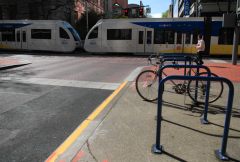
(Photos © J. Maus)
Portland’s transportation future is set to change drastically in the coming years. The stars are aligning for a city — and especially the downtown core — where public transit, feet, and bicycles are the vehicles of choice for most people.
Don’t believe me? Just look around at recent headlines and community and political trends for evidence.
Today we heard two announcements of projects that will have a major impact on the volume of car traffic in the urban core. U.S. Secretary of Transportation Ray LaHood called local officials to announce that Portland has secured $75 million to take its streetcar line across the river. The new line will go from Northwest Portland, across the Broadway Bridge, and then south to OMSI.
We also heard plans from Mayor Adams this morning that the Bureau of Transportation will build a new cycletrack on SW Broadway by removing an existing motor vehicle lane. They also announced plans to unveil another new bikeway design in Portland — the buffered bike lane — sometime next week.
This is propitious timing for streetcars and bikes, given that next week PBOT will launch a series of important open house events for the update of their bicycle and streetcar master plans. Those two plans are being updated simultaneously and, with a vision toward a transformed city in years to come, officials thought it wise to tie those plans as closely together as possible.
The goals of both master plans have one major theme in common; to reduce Vehicle Miles Traveled (VMT). VMT is wonk-speak for how many miles people travel in their cars. It’s a metric used by planners for how well a city does in providing options like biking, walking, and transit.
“Working together to reduce VMT,” was a mantra that came up during a recent meeting about the open houses. Now that’s something I can get behind.
In more VMT news, in Salem last week I listened to a City of Portland lobbyist urge House Transportation Committee members to allow a pilot program in Portland that would tie vehicle registration fees to VMT (read more about that in The Oregonian). No word yet on whether this will be included in the Governor’s big transportation bill, but it shows where the city’s policies are headed.
But that’s just start of what I see as an idea that is gaining serious momentum. You can also see Portland’s low-car future in the local bike scene. We all know how cargo and family bikes have taken off in this city. Clever Cycles on Hawthorne made Portlanders re-think their relationship to bicycles and they’ve reaped the benefits by having a very successful first year of business.
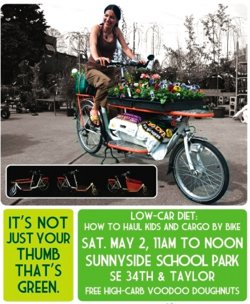
Joe Bike, another shop on Hawthorne and a newcomer to the utility bike scene, has also jumped into supporting the car-free/low-car lifestyle that so many Portlanders aspire to. This weekend, Joe Bike will host a “Low Car Diet Clinic“, that will help show folks how to haul kids and cargo by bike.
If you think going on a low-car diet is some small, inner-Southeast phenomenon, consider a recent, citywide survey by the Bureau of Planning and Sustainability. As part of their Central Portland Plan, they asked people at events throughout Portland about what “Bold steps” they’d like the city to take downtown. Three of the top ten ideas that got the most responses were: “Increase car-free streets and zones”, “Increase and improve bike lanes,” and “Create bike only streets.”
People are beginning to realize that a low-car city is an enjoyable and livable city.
Another person who has noticed these stars aligning is blogger and citizen activist Chris Smith. Smith, who’s also Chair of the Citizen’s Advisory Committee to Portland Streetcar, has been working on what he refers to as “an organizing principle” for “carbon free central city mobility”.
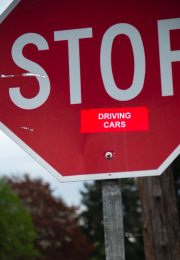
at Ainsworth yesterday.
I’ll sit down with Smith next week to hear more about it, but it’s essentially his way of trying to get people to think about a central city that doesn’t need cars. A big part of his thinking is that by 2011, streetcars will surround the entire central city.
Another group with car-free downtown aspirations are pedicab operators. Several pedicab business owners have recently joined forces to form an organization. According to Portland Cascadia Pedicabs owner Ryan Hashagen, one idea they plan to work on together is a closure of some downtown streets between late-night and early-morning hours (Their concern is the safety risk posed by the high number of people who drive drunk after leaving nightclubs and bars).
To me, all the things above taken together make Portland — especially downtown — primed for a low-car future.
I think a local political leader (Mayor Adams perhaps?) could take all these separate, yet connected trends and push the idea to the next level by starting a “Low Car Diet Fridays” campaign (Commissioner Leonard has already said he likes the idea of a carfree South Park Blocks).
The idea would be to encourage folks to make smart trip choices and perhaps leave their cars at home on one day of the week. There would be no political risk (it’s just a suggestion after all) and it would be a perfect way to help broaden the conversation about trip choice and VMT beyond wonky, planning circles. I think if we focus on trip choices rather than biking specifically, the message would be much more palatable to a larger number of Portlanders.
What do you think?


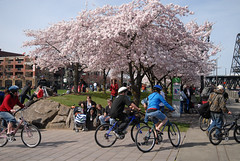
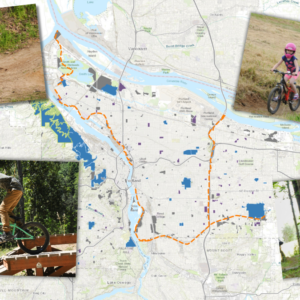

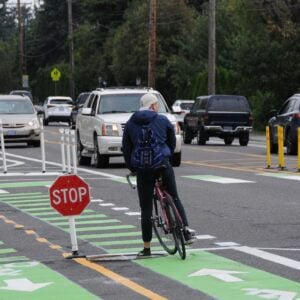

Thanks for reading.
BikePortland has served this community with independent community journalism since 2005. We rely on subscriptions from readers like you to survive. Your financial support is vital in keeping this valuable resource alive and well.
Please subscribe today to strengthen and expand our work.
excellent. let’s start with the Park blocks. as for firetrucks, let’s install retractable barricades or even just ’emergency vehicle only’ signs.
IMO another one of the stars being aligned is the generation of Portlanders that are being raised here. Don’t leave the kids out of the equation! My 6 year old, when about to cross the street mid block to go play with a friend, and when asked by me if she saw any traffic, yelled back to me “Nope! No bikes!” That speaks mountains to the paradigm shift that can take place if we just keep chipping away.
(In the spirit of full disclosure, she wants our streets to be car-free so the neighborhood dogs and cats can be safer.)
Thanks for the inspiring article. This town has changed so much in the 18 years I’ve been here. I’ve always biked, but the whole experience has really improved.
I agree with Anglea #2 that young Portlanders totally get it. My 8 and 5 year olds love to bike, know why it is good for their health, the planet and the family budget, and look for ways to reduce how much we drive. They also understand intuitively the value in a simple, local way of life without frequent road trips or travel by airplane. A bike to school, a decent playground, a farmer’s market on Thursdays, and no TV in the house. This is way different than how I grew-up!
-Ian
since they keep adding more car parking capacity downtown every time another high-rise is constructed, the number of cars in downtown isn’t likely to get smaller anytime soon…
It’s nice to see we’re on the right track, especially when it comes to creating more bicycle and pedestrian amenities to discourage driving.
However, I’ve never been a fan of the streetcar as practical urban transportation. The car seats relatively few passengers (when compared to a bus or MAX train) and frankly seems more touristy than truly practical.
Beth #5.. using the existing speeds,use,etc of the current streetcar as for what to expect with streetcar is not accurate. That system goes through the urban core and has many obstacles to slow it down. I would expect streetcars in other parts of town to reflect bus speeds. I know regular busses downtown are pretty slow too, until they leave the urban core, and then pick up considerable speed.
But my dislike of the streetcar is that it shares roadway with other users, esp cars. I would love to see,where possible,for streetcar alignments to be transit only, perhaps sharing with busses,but off limits to cars. Then some real speed and efficiency would happen.
#4 BURR:
That, right there, is exactly why downtown will never be car free. There are something like 40,000 parking spaces in garages downtown and in the Pearl District. That’s $$$$$$
We’re going to need to focus more on land use if we’re going to achieve a region where autos are no longer the primary source of transportation. Despite all the progress we’ve made, there are still many trips across the region where no other practical (to the majority of residents) alternatives to a the car are available. We need to get more people living closer to jobs, goods and services, as well as improving the cycling, pedestrian and transit infrastructure – all across the region, not just in Portland.
I’m fully confident we’ll accomplish that goal eventually, but I fail to see how a 12-lane, $4 billion freeway project moves us in that direction.
add shout out from the decembrists on colbert report monday nite to list:
http://www.colbertnation.com/the-colbert-report-videos/225969/april-27-2009/the-decemberists
Beth, you don’t sit on the streetcar, you stand 🙂 However, I find it quite useful as I ride it to work when I don’t bike (rain). It has too many stops as it stands now, but the eastside line will have longer distances in between and should be much quicker. They really should lose a few stops and reuse the shelters on the eastside. I.e Alder, Everett, NW 12th…
Portland is primed for a low-car diet, but has decided to binge feed on a 12 lane bridge instead.
Portland is primed for a low-car diet, but has put its future in the hands of a selfish, weakened Scam Adams.
Portland is primed for a low-car diet, but is plagued by legions of self serving advocates (BTA).
Portland is primed for a low-car diet, but populated by millions of people who already own cars and have billions invested in infrastructure for them.
Portland is primed for a low-car diet, but is full of people who are surprised by the riding conditions outside of inner southeast (BikePortland).
I could do this all day. Heads in the sand now, you special little people!
Amy Ruiz for mayor!
Beth, Joe’s right — the current slow “collector” style streetcar route will differ from the higher speed “commuter” routes that will eventually go up Belmont or Hawthorne etc. Not sure how MLK/Grand will work, but there’s good discussion about all this at Chris Smith’s Portland Transport blog.
That said, I agree with Joe that ultimately, we need dedicated streetcar-only lanes to keep mass transit moving faster than cars and thus encouraging more drivers to use them.
I love the idea of making car free streets dedicated to only bikes (in a separate lane from the streetcars, of course) and light rail. What are the obstacles to that arrangement, besides the usual political flak for removing car lanes? Seems like there’d still be plenty of car lanes if we made 5th and 6th bike + streetcar only. Failing that, how about making the Park Blocks bike only and bike friendlier? I’m still not convinced that Broadway is the best place for N-S bike traffic, but maybe the plan to be announced next week will change that.
Bikes alone won’t cause us to have have car free or car-lite central cities. Bikes are great, but they don’t work for everyone or every trip, at least not without a complementary public transport component. As in Europe, they have to go hand in hand (thought not wheel in track) with light rail and buses in order to achieve the critical mass of non-drivers needed to make the economy work, which is why we need to find ways to work cooperatively with the streetcar folks as allies against car-centric planning.
We’re far from perfect, but let’s acknowledge that a lot of important city decision makers here do seem to get it, unlike almost every other American city (NYC, Chicago, and a few others excepted).
GLV, they can keep the parking garage monstrosities that already did so much damage to downtown if they’ll just gradually remove much of the street parking and turn it over to cycle tracks or bike lanes. Isn’t it mostly repainting and re-signing?
I have to agree that the biggest impediment to seeing anything resembling a car-free downtown (let alone more car-freeness elsewhere) is infrastructure. Not just the infrastructure that already exists to support autos and in many cases isn’t particularly easily or cheaply transformable to cycling infrastructure, but the widespread lack of cycling support across economic classes. People love to tout cycling as a cheap alternative to driving, but it’s not so cheap if your bike is repeatedly stolen or damaged in theft attempts because there is an utter lack of secure bike storage. I keep mine in my (small) apartment because my building has no secure place for bikes, though it does have a parking lot. Because of that, I have no room for trailers or dutch-style whatevers or spendy dohickeys handbuilt the creative class of Portland’s lily-white elite. A lot of others are in the same position — we’re just trying to hold on, stay or get employed, feed ourselves and maybe have a little left over for a beer or coffee or movie once in a while. The infrastructure exists to support those who choose a car as their transit mode; it barely exists to support those who chose a bicycle, and the only places I’ve seen that changing (and only slightly) are very high-end condos marketed to hipsters, which of course are right up our developers-best-friend Mayor and his cohort, Randy “Neon” Leonard, but leave most of us out in the cold.
What you’re talking about is nice, but it’s very bourgeois, like so much of “bike culture” in Portland — expensive, trendy, hip, cultish. I realize you have advertisers, I realize a good deal of your audience has a lot of disposable income and you need to cater to them, but to realize a vision of true “car-freeness,” you have to move beyond the Oregon Manifest/OBRA crowd who shop at Bike Gallery and Clever Cycles and think nothing of $250 for a rain coat or $150 for a smartwool sweater. It’s foolish to pretend otherwise, and I don’t see any plans to accommodate anyone not part of these cliques.
I wish they’d have initially built the downtown rails under ground or on elevated platforms, that’s what I think 🙂 It would have been faster and more convenient for transit riders and less hazardous for bike riders.
At any rate, if downtown organically moves in a car-free direction as a result of global demand for energy outstripping supply, I’m okay with that — I don’t think it should be forced. I think we would come across as an overly demanding minority attempting to impose our will upon the majority if we did try to force it.
However, I have rethought my response to you in the other thread regarding how to improve the cycling experience for those intimidated by heavy traffic, and have decided that bike boulevards could indeed work well in certain parts of downtown. Two north-south running streets and maybe four east-west running streets would be good. Park and 9th would be the best north-south streets. They aren’t used a lot by cars as it is. Some of the crossings could be improved, especially around Burnside, and big sharrows could be painted. Maybe parking could be banned on them. People could lock up there, and walk to their destination if they don’t want to ride on streets like Broadway.
I already voiced my opinion regarding cycletracks in response to the other article 😀
Burr @ 4:
Right you are. I wish that the city government had simply modified zoning laws to allow the downtown area to develop as just another neighborhood, albeit a somewhat higher density one. I hate those high rises, and they’re not profitable without subsidies (and even then, only as affluent condos or low-income section 8 housing). Without the subsidies, maybe we would be seen more NYC brownstone and Chicago 3-flat type housing, which are far more livable and make a lot more sense economically.
@ MichaelM (#14):
Part of the issue is demographic and part of it is geographic.
Inner Southeast IS lily-white, but it is also laid out in much smaller, neater little grids that all connect and make sense. SE Portland also has access to more bridges that are adequately bike-accessible than the N/NE neighborhoods north of Burnside do. The combination of the two created the climate that helped spur so much change for cyclists and pedestrians in that part of Portland.
N/NE Portland, particularly those neighborhoods north and west of Irvington, was for many decades home to communities of color — whose cultural mindset STILL sees the bicycle as a vehicle of last resort for the very poor. (If you’re not convinced, take a rush-hour trip through N/NE, all the way up Williams to Lombard, and count the numbers of people of color riding bicycles for transportation.) In these communities, car ownership continues to be the desired goal. Until we begin to confront those realities honestly (along with the broader, related issues of gentrification and race) and reach out more to cultures who still see the car as the end goal, we will continue to see bike amenities by and for white people with money.
I think that some things are being done right and could use more support. Sunday Parkways (which is still accepting volunteers, BTW) is a great example. I’d love to see MANY more of these kinds of events first, ESPECIALLY in the underserved neighborhoods like Arbor Lodge and St. Johns, before we start talking about trying to find money for major infrastructure changes. I’d like to see more events like this that reach across demographic lines and bring neighbors together.
Build your base of support first, THEN start the heavy planning.
the city actually requires developers to provide minimum amounts of parking to support their development, and the developers themselves are almost completely car oriented, they’d laugh out loud at most of the commenters here
Good article Jonathan. I look forward to the time when we have bicycle only parking garages. The Doubletree Hotel for example has limited bike parking. The parking they do have for bikes is at the entrance to the parking structure where cars often can be found idling. For many of the “green” buildings in Portland bike parking is an afterthought. Perhaps it’s unhealthy to situate bike parking near idling vehicles?
The cycling friendly winds of Portland are blowing east to Idaho and with articles like this, will plant the seeds to inspire and encourage our cities and towns to follow Portland into the CycloFuture. I only wish I still lived in Portland so I could participate in this awesome movement from ground zero.
About the phrase “low-car diet”. Somebody from Zip Car called me at the shop today to point out that that company has a trademark on it and I don’t. They very politely asked me to change the language in the future. So, yes, it’s theirs. Sorry.
@ beth h#5
True that the streetcar may not be any more practical than a bus, but don’t dismiss or underestimate the value of “touristy” modes to add diversity and legibility to the streetscape. It’s not just about moving people from point A to point B — it’s about creating great places worth spending time in.
streetcar tracks in the ROW = emergency room trips for cyclists
:thumbs down: on that shit